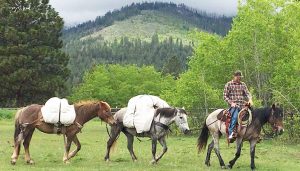
When you think of mustangs, wide open spaces and lush meadows with a herd of pretty horses in the middle come to mind. But the sad fact is that there are more than 88,000 wild horses and burros on land that can adequately feed and water about 26,000. With the horses, burros and the range they live on spread out over 10 western states, you would think there would be enough ground and feed for all, but there isn’t. It’s not only the land that is damaged by overgrazing but the animals also are affected. With little feed on the ranges, the animals have to travel farther and farther for that and water. The eventual outcome is starvation for many of these animals.
In 1971, the Wild, Free-Roaming Horse and Burro Act was established by the Bureau of Land Management and the Forest Service. This act directs the BLM to remove excess animals from over-populated herds and offer them to the public for adoption or purchase. The horses and burros are rounded up by horses with some helicopter assistance. Animals are also trapped at watering holes. According to the BLM website, more than 245,000 wild horses and burros have been adopted or purchased since 1971.
This Thursday, June 20, the BLM will be having an adoption event at the Ravalli County Fairgrounds. It will run through Sunday, June 23. According to Jerrie Bertola, range management specialist for the BLM, there will be over 100 horses and burros at the event. Although there is only one recognized wild horse herd in Montana, the Prior Mountains Wild Horse Herd, most of the horses at this event will be from Oregon and California, and the burros are from Arizona and Nevada. There will be about 12 yearlings and the oldest horse is around seven years old. These animals are what Bertola called “fresh” or newly captured.
The adoptions will occur onsite at the fairgrounds. The applications need to be approved there, or a pre-approval via the internet must be shown to the officials there. For horses, the adoptee must have a six-foot-tall wooden or metal fence or round pen. They do not want the horse to go directly into a wire enclosure. There is a nominal cost for the adoption but there is also an incentive to adopting one of these animals. Upon approval and adoption, the adoptee will be given $500 to take the horse. Then, 60 days later, another $500 is given. During this one year period, the horse or burro cannot be sold, moved, or rebranded. Clear titles to the horses and burros are given after a year’s possession. The first year is called fostering.
‘Mustang Matt’ Bischof resides north of Hamilton and has been working with these wild horses for several years and is a certified TIP (Trainer Incentive Program) trainer through the Mustang Heritage Foundation. These trainers bridge the gap between the public and excess wild horses that are held at centers around the West. These trainers like Mustang Matt are paid by the BLM. These horses must be halter-trained, load in a trailer and gentle enough to have their feet picked up.
Mustang Matt will have three horses at the event in Hamilton this week that he got last year. One, a little buckskin mare, was a ‘three strikes you’re out’ horse. This type is deemed undesirable as she wasn’t adopted at three different events. Today, she is a well-broke horse that he used to hunt on last fall, lets his daughter ride, and is, in his words, an “all around good horse.”
“She will be my ambassador,” he said. “She shows everything good about a mustang, extremely versatile, good feet, a product of natural selection.”
Mustang Matt says he is an advocate for these horses that need homes but he also realistic. This is a lot of hard work and it takes a lot of patience to win the horse or burro over. “I will be taking everything at the horse’s pace and explaining and demonstrating the effectiveness of positive reinforcement. It’s miscommunication that gets us into trouble. We want to build trust and respect in the animal, and have them have the same with us humans.”
The adoption event will be from 2 to 6 p.m. on Thursday. Friday and Saturday, the event will run from 8 a.m. to 6 p.m., and on Sunday, the event will end at 12 noon. The public is invited to attend, if only to say you’ve seen a wild horse. If you’re planning on adopting, bring your trailer and have your corral set up in advance.